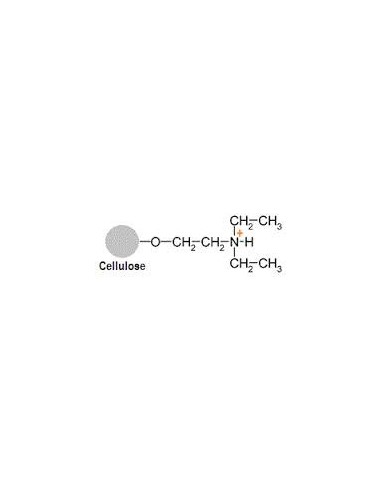What should you know about Deae Cellulose Ion Exchange Chromatography?Posted by Biophoretics on November 10th, 2020 Ion exchange chromatography is the reversible adsorption of charged molecules to immobilized ion groups on a matrix of an opposite charge. Separation can be selectively achieved by adsorption and release of samples from the matrix. Ion exchange starts with the equilibration of the exchanger using pH, and ionic strength. During equilibration the exchangeable groups are associated with counter ions. Once equilibrium is reached and the sample added the molecules undergo addition and adsorption with an appropriate charge displace the counter ions and bind reversibly to the matrix. The unbound materials will pass through the column with the void volume. In the third stage, substances are removed from the column by increasing the ionic strength of the eluting buffer.
Media Deae Cellulose Ion Exchange Chromatography media is an insoluble matrix with charge groups covalently attached. Negatively charged exchangers bind positively charged ions (cations). Exchangers bind one type of cation but, when presented with a second type of cation, it may displace, and/or exchange with, the first. These resins are called cation-exchange resins. Anion-exchange resins are positively charged and bind and/or exchange negatively charged ions (anions). Several side-chain groups of the amino acid residues in proteins are ionizable (e.g. lysine or glutamic acid) as are the N-terminal amino and C-terminal carboxyl groups and so proteins are charged molecules. This characteristic can be used to separate different proteins by ion-exchange chromatography. Types of Exchangers Two weak exchangers can be used for protein separation are carboxymethylcellulose (CM-cellulose) and diethylaminoethyl-cellulose (DEAE-cellulose). These covalently cross-linked agarose bead ion celluloses have been chemically modified. Deae Cellulose Ion ExchangeChromatography has a carboxymethyl functional group -CH2OCH2COOH. At neutral pH the carboxymethyl group is ionized as -CH2OCH2COO¯ so that CMcellulose is negatively charged, so it is a weak cation exchanger. DEAE-cellulose contains a diethylaminoethyl group. It is positively charged at neutral pH and so DEAE-cellulose is a weak anion exchanger The Sepharose types are particularly useful for the separation of high molecular weight proteins. In practice, since these matrices are very similar to those used for gel filtration some molecular sieving may accompany the ion-exchange process. Like it? Share it!More by this author |



